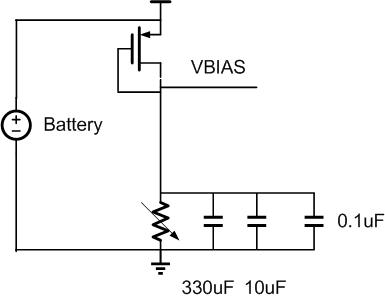Keithley low noise source vs potentiometer bias: Noisier?
Which biasing will be more noisier?
Resistor biasing using a potentiometer (acting as current source)
External Keithley low noise source.
Since resistor is passive , it should be low noise than keithley, right?
do you mean a DC source? Sometimes I use a battery driving a potentiometer, followed by a 330 uF electrolytic, 10 uF ceramic, and .1 uf Ceramic cap. That seems to be very low noise.
Resistors DO have thermal noise, but the capacitors seem to keep it in check. Things like AC powered instruments can be low noise, but the ground loops off of their chassis is often the biggest noise source.
What is your frequency band of interest. Very likely biff44 option gives lowest noise.
If your interest is in very low frequency, the type of resistor may affect noise performance. Metal foil or wire wound resistors show lowest current noise floor at low frequencies. For "metal film" resistors, it may vary (depending on film thickness). Carbon and thick film resistors are worse.
Thank you WimRFP and biff44 for replying! Is the biasing same as attached in figure or I got it wrong?
My circuit is 2.4GHz receiver. What kind of resistor suits this application better?

If the bias resistor is in a 2.45 GHz LNA, or other amplifier circuit (so not an oscillator), I would select the resistor based on its RF and mechanical specifications as its noise at RF is just thermal noise.
When the resistor is not in the RF-path (for example because of decoupling), RF specs are no longer of importance.
Hi WimRFP,
I am going to bias a source follower buffer at baseband (10MHz) for CMOS RX. How do you choose onchip resistors for better noise at 10MHz? Polysilicon, diffusion?
Is it better to connect caps between VBIAS and VDD so that supply noise effect is minimized?
In your schematic I do not see where the noise output is taken. The line to the right is so well blocked by several capacitors, that I cannot see how any noise power may be generated.
For 2.4 GHz the easiest noise source (and quite powerful to test receivers) is a RF transistor e-b diode connected in reverse to a 9V battery through a 1 kOhm potentiometer. Adjust 5-10 mA for the avalanche current and connect a quarter-wave long piece of wire as an antenna.
Works fine to ~12 GHz, a typical ENR is ~30 dB (300 000 K noise temperature)
